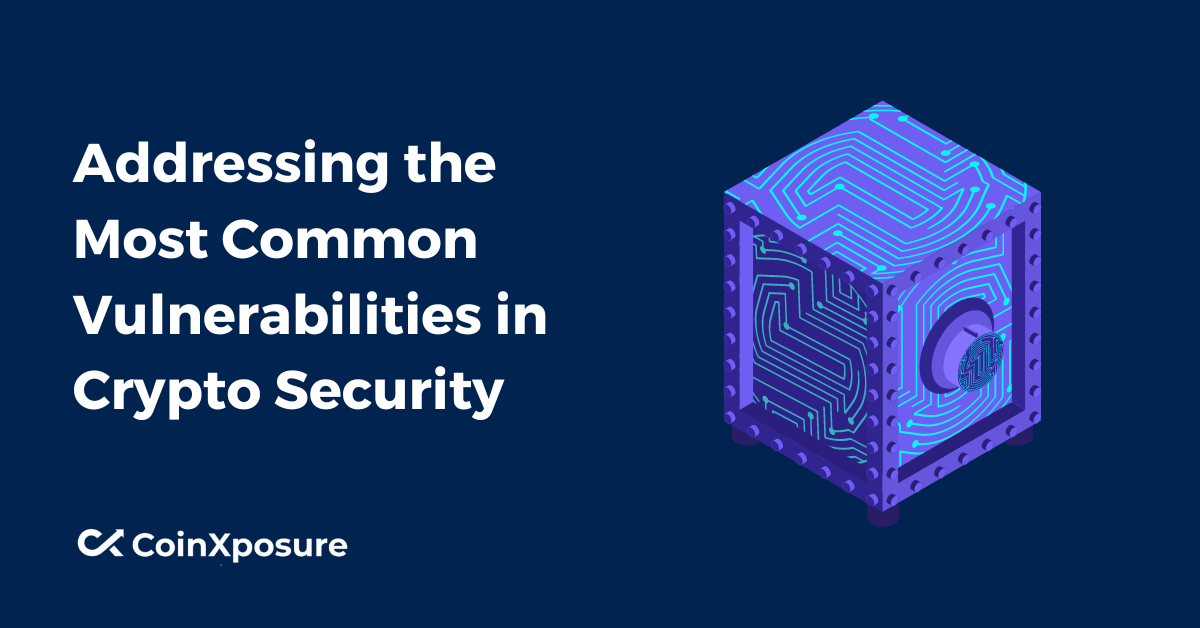In the dynamic landscape of cryptocurrencies, the burgeoning popularity of digital assets has been accompanied by an increased risk of security vulnerabilities.
Addressing these vulnerabilities is paramount for safeguarding the integrity of crypto transactions and protecting users from potential threats.
This article explores some of the most common vulnerabilities in crypto security, delving into key aspects such as key management, phishing attacks, exchange vulnerabilities, smart contract exploits, and malware threats.
By understanding and proactively mitigating these risks, the crypto community can fortify its defenses and foster a more secure environment for participants in the digital financial realm.
Common Crypto Security Vulnerabilities
Cryptocurrency, despite its innovative potential, is not immune to security challenges. As the digital landscape evolves, various vulnerabilities have emerged, posing risks to the integrity and safety of crypto transactions.
Understanding these common security pitfalls is crucial for users and organizations alike, as it enables the implementation of robust protective measures.
Let’s delve into some of the prevalent vulnerabilities in cryptocurrency security to better appreciate the need for proactive defense mechanisms:
- Key Management Issues:
- Inadequate protection of private keys.
- Risks associated with storing keys on vulnerable devices.
- Phishing Attacks:
- Deceptive schemes targeting users to reveal sensitive information.
- Fraudulent websites and communications mimicking legitimate platforms.
- Exchange Vulnerabilities:
- Risks associated with centralized exchanges.
- Security breaches leading to unauthorized access and fund theft.
- Smart Contract Exploits:
- Vulnerabilities in code execution leading to exploits.
- Risks associated with poorly audited or flawed smart contracts.
- Malware and Ransomware:
- Targeted attacks aiming to compromise cryptocurrency wallets.
- Risks of malicious software stealing private keys or demanding ransoms.
Understanding and addressing these vulnerabilities is crucial to fostering a secure environment within the cryptocurrency space.
Mitigation Strategies in Crypto Security
Mitigating the identified vulnerabilities in cryptocurrency security is essential for maintaining the trust and integrity of the digital financial ecosystem.
Effective strategies not only help in preventing potential threats but also contribute to creating a more resilient environment for users.
The following are key mitigation strategies designed to address and counteract common vulnerabilities, safeguarding the assets and information of participants in the cryptocurrency space:
- Education and Awareness:
- Promote awareness about common threats and best security practices.
- Educate users on identifying phishing attempts and practicing caution.
- Two-Factor Authentication (2FA):
- Implement 2FA for an additional layer of account protection.
- Require multiple authentication factors to enhance security.
- Regular Security Audits:
- Conduct routine audits of wallets, exchanges, and smart contracts.
- Identify and address vulnerabilities discovered during audits promptly.
- Cold Storage Solutions:
- Encourage the use of cold wallets for long-term storage.
- Keep a significant portion of assets offline to minimize exposure to online threats.
- Regulatory Compliance:
- Ensure compliance with relevant local and international regulations.
- Uphold legal standards to foster a secure and transparent crypto environment.
Implementing these mitigation strategies collectively fortifies the overall security posture of the cryptocurrency ecosystem, reducing the risk of vulnerabilities and enhancing user confidence in digital asset transactions.
Conclusion
Safeguarding the integrity and security of cryptocurrency transactions is imperative in the face of evolving digital threats.
The exploration of common vulnerabilities, ranging from key management challenges to sophisticated phishing attacks, underscores the need for proactive measures.
The crypto community can significantly enhance its defenses by adopting robust mitigation strategies such as user education, two-factor authentication, regular security audits, cold storage solutions, and adherence to regulatory compliance.
As the cryptocurrency landscape matures, a collective commitment to addressing vulnerabilities is essential for fostering trust among users and stakeholders.
Emphasizing the importance of ongoing vigilance and adaptability in the ever-changing security landscape is crucial.
By doing so, the crypto space can cultivate a resilient environment, ensuring the continued growth and adoption of digital assets with confidence and security.












